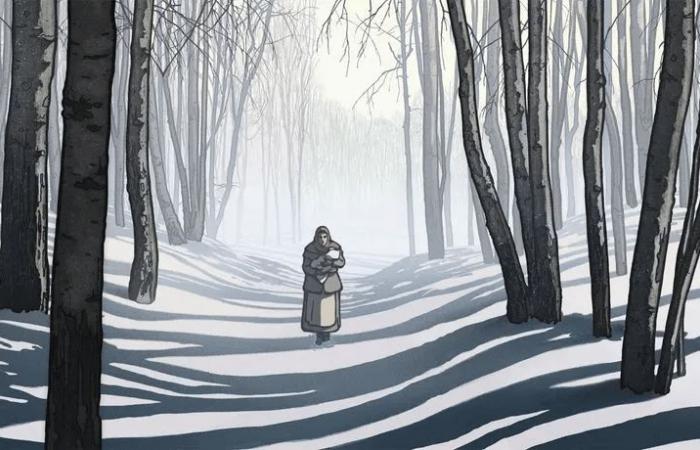Cinema release –
Michel Hazanavicius tackles animation
The French director signs “The Most Precious of Goods”, an animated film set against the backdrop of the Shoah, released this week in French-speaking cinemas.
Published today at 10:31 a.m.

“The Most Precious of Goods”, released in theaters on November 20, 2024.
@STUDIO CANAL
Subscribe now and enjoy the audio playback feature.
BotTalk
After tackling comedy with “OSS 117”, the silent film with “The Artist”, the historical biopic with “Le redoutable”, and the “zombific” genre with “Coupez!”, Michel Hazanavicius returns for a first animated film dedicated to the Shoah. The result is a nice, rather smooth film, which nevertheless struggles to find its audience.
“The Most Precious of Commodities” is an adaptation of the eponymous tale by Jean-Claude Grumberg. The story immerses us in the Polish countryside of the 1940s, where “poor woodcutter” and “poor woodcutter”, a couple of poverty-stricken peasants, live. Their lives are turned upside down the day they discover a baby on the side of the railway located not far from their hovel.
At this point you will find additional external content. If you accept that cookies are placed by external providers and that personal data is thus transmitted to them, you must allow all cookies and display external content directly.
Allow cookiesMore info
The toddler, safely thrown away by his Jewish parents who were traveling towards Auschwitz, is adopted by “poor woodcutter”. Ready to die to defend this child, she protects him against everything, starting from her husband, an anti-Semite, and the inhabitants of the village, wishing to denounce her.
“I wanted to make a film aimed at children, and the story has an important educational value,” shares Michel Hazanavicius, during an interview with the “Tribune de Genève”. It is true that through its purpose and its moral, the film carefully chooses simple words to address this serious theme that is the Shoah.
Narrated by the voice of Jean-Louis Trintignant (one of his last cinematic appearances before his death in 2022), “The Most Precious of Commodities” also finds its depth in the sobriety of his drawings. “For me, it was essential to get my hands dirty, sketching the characters and drawing certain scenes,” explains the director.
For children?
Some of them are reminiscent of “The Scream”, by Edvard Munch, when the faces of the dead appear on the screen, in silence, for more than a minute. Isn’t that a bit traumatic for children under 10?
“No,” defends Michel Hazanavicius. Children have all kinds of different sensitivities, so what scares one person won’t necessarily scare another. The film was shown to dozens of children who did not complain.”
Prepare the tissues
Far from spoiling the film, this sequence still raises the main problem of the work. Difficult to understand who it is intended for. Casually, and this is rare for Michel Hazanavicius, we have the impression that he made it with one arm tied behind his back, trying to reach a very young audience while trying not to forget the adults.
“The critics will say what they want, it’s no longer my problem anyway,” says the filmmaker bitterly. Never mind, here’s one: the film is good, touching, and demonstrates great accuracy. We are only left a little unsatisfied, perhaps regretting a lack of risk-taking. Do the tears that come to us during the finale stem from the subject of the film or from the way in which it is treated? That is the question.
Rating: ** Drama/Animation (France – 81′)
Andrea Di Guardo has been a journalist at the Tribune de Genève since March 2024. Locally, he is also interested in cultural and international subjects. He holds a Master’s degree in journalism and communication and a Bachelor’s degree in political science.More info
Did you find an error? Please report it to us.
0 comments






